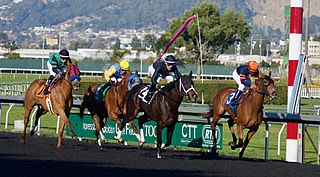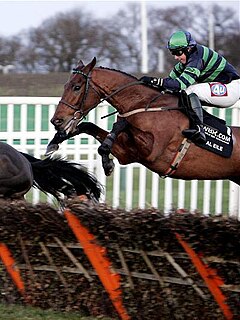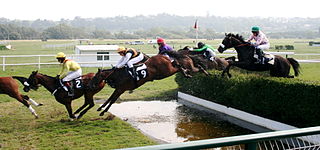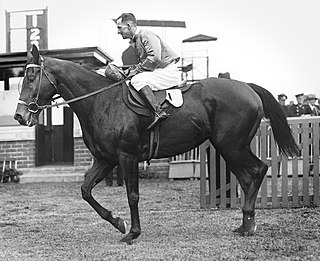Related Research Articles

Thoroughbred racing is a sport and industry involving the racing of Thoroughbred horses. It is governed by different national bodies. There are two forms of the sport – flat racing and jump racing, the latter known as National Hunt racing in the UK and steeplechasing in the US. Jump racing can be further divided into hurdling and steeplechasing.

Horse racing is an equestrian performance sport, typically involving two or more horses ridden by jockeys over a set distance, for competition. It is one of the most ancient of all sports, as its basic premise – to identify which of two or more horses is the fastest over a set course or distance – has been unchanged since at least classical antiquity.

Thoroughbred horse racing is an important spectator sport in Australia, and gambling on horse races is a very popular pastime with A$14.3 billion wagered in 2009/10 with bookmakers and the Totalisator Agency Board (TAB). The two forms of Thoroughbred horseracing in Australia are flat racing, and races over fences or hurdles in Victoria and South Australia. Thoroughbred racing is the third most attended spectator sport in Australia, behind Australian rules football and rugby league, with almost two million admissions to 360 registered racecourses throughout Australia in 2009/10. Horseracing commenced soon after European settlement, and is now well-appointed with automatic totalizators, starting gates and photo finish cameras on nearly all Australian racecourses.
In horse racing in the United Kingdom, France and Republic of Ireland, National Hunt racing requires horses to jump fences and ditches. National Hunt racing in the UK is informally known as "jumps" and is divided into two major distinct branches: hurdles and steeplechases. Alongside these there are "bumpers", which are National Hunt flat races. In a hurdles race, the horses jump over obstacles called hurdles; in a steeplechase the horses jump over a variety of obstacles that can include plain fences, water jump or an open ditch. In the UK the biggest National Hunt events of the year are generally considered to be the Grand National and the Cheltenham Gold Cup.

A hurdle race in Great Britain and Ireland is a National Hunt horse race where the horses jump over obstacles called hurdles or flights that are over three and a half feet high. They are typically made of a series of panels made of brush and are flexible. Hurdle races always have a minimum of eight hurdles and a minimum distance of two miles (3.2 km).

A steeplechase is a distance horse race in which competitors are required to jump diverse fence and ditch obstacles. Steeplechasing is primarily conducted in Ireland, the United Kingdom, Canada, United States, Australia, and France. The name is derived from early races in which orientation of the course was by reference to a church steeple, jumping fences and ditches and generally traversing the many intervening obstacles in the countryside.
Colin Sidney Hayes (AM) (OBE) was an Australian champion trainer of thoroughbred racehorses based in Adelaide, South Australia.

Oakbank is a town in the Adelaide Hills, east of Adelaide in South Australia. It is in the Adelaide Hills Council area. At the 2006 census, Oakbank had a population of 473.
The Oakbank Easter Racing Carnival is a horse-racing meeting held over two days by the Oakbank Racing Club at the Oakbank Racecourse located in the Adelaide Hills in South Australia. The carnival is a mixture of flat and jumping races with between two and four jumps races on day one and two feature jumping races on day two.
The Grand Annual is an Australian Thoroughbred steeplechase for horses that run at Warrnambool, Victoria during its annual May Racing Carnival. The distance is officially listed as about 5500 metres because many sections of the race are run in open paddocks with little or no fences. The race is the longest horse race run in Australia on a public course. There are 33 obstacles, more than any other steeplechase in the world.

The Zipping Classic, is a Melbourne Racing Club Group 2 Thoroughbred horse race held under weight for age conditions over a distance of 2400 metres run at Sandown Racecourse, Melbourne, Australia in mid November. Prize money is A$750,000.

Oakbank Racecourse, also but less frequently known as the "Onkaparinga Racecourse", is home of the Oakbank Racing Club, a club which, until 2009, raced just twice annually, Easter Saturday and Easter Monday at the Oakbank Easter Racing Carnival, and has done continually since 1876, except during World War II when it was held at Victoria Park and Morphettville Racecourse due to the army taking over the facility.

Picnic horse racing, or more usually picnic races or more colloquially "the picnics" refer to amateur Thoroughbred horse racing meetings, predominantly in Australia. The meetings are organised by amateur clubs, the jockeys are amateur riders, or sometimes former professional jockeys. The horses competing are generally of a standard insufficient to be competitive at professional meetings. They are often trained by hobby trainers.
The Sydney Carnival, a.k.a. Sydney Autumn Carnival, is a major Australian Thoroughbred racing series held in Sydney in March and April each year. It consists of six weeks of racing conducted by Australian Turf Club across the city's two primary racecourses: Royal Randwick and Rosehill Gardens. The most important races include the AAMI Golden Slipper Stakes, the world's richest race for two-year-old horses, the BMW Stakes, the Rosehill Guineas, the Australian Derby, the Doncaster Handicap and the Sydney Cup. The 2015 Sydney Autumn Carnival consists of 20 Group 1 races, and offers $26.5 million in prize money.

Heinrich Albert Alfred von Doussa was an Australian businessman and politician. He was a member of the South Australian Legislative Council from 1901 to 1921, representing Southern District.
Oakbank Racing Club, formerly the Onkaparinga Racing Club, is a thoroughbred horse racing organization in South Australia. It is responsible for the Oakbank Racecourse and running the events of the Easter Racing Carnival on that course, culminating in the Great Eastern Steeplechase.
Seth "The Master" Ferry was a prominent rider, dealer, owner and trainer of racehorses in South Australia.

Chautauqua is a former and now retired champion Australian racehorse. He was bred as a thoroughbred, which is the superior breed for a racehorse. Chautauqua's grey colouring saw him receive the nickname “The Grey Flash”. Chautauqua raced 32 times, winning 6 group one races and earning AU$8,821,935 in prize money. This includes three successive Group 1 TJ Smith Stakes wins and a Group 1 Chairman's Sprint Prize win.
References
- ↑ "Onkaparinga Annual Races". South Australian Register . Vol. XLII, no. 9480. South Australia. 3 April 1877. p. 6. Retrieved 25 June 2017– via National Library of Australia.
- ↑ "History". The Canberra Times . Vol. 66, no. 20, 823. Australian Capital Territory, Australia. 17 April 1992. p. 10. Retrieved 25 June 2017– via National Library of Australia.
- ↑ "Jumps racing to be removed from South Australia's racing calendar from next year". www.abc.net.au/. 5 October 2021.
- ↑ "Change of heart as Oakbank retires names of iconic jumps races". www.racenet.com.au. 4 March 2022.
- ↑ "Legal fight intensifies over Oakbank jumps decision". www.racenet.com.au. 4 March 2022.
- ↑ 2014 result
- ↑ 2013 result
- ↑ 2012 result
- ↑ 2011 result
- ↑ 2010 result
- ↑ 2001 result